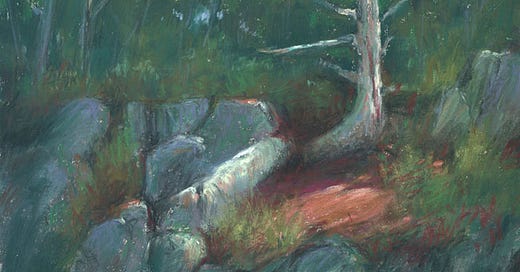I've been teaching outdoor painting workshops now for over 20 years, and I've taught hundreds of students, from beginners to professionals. Over the years, I've seen some of my students struggle in three areas: gear setup, painting basics and drawing skills. (The latter even among some professionals who are selling their work!) If I could create a "sure-fire," one-day lesson that would teach these, and plan it for Monday, they would enjoy the five-day workshop so much more.
Not knowing how to set up your gear is like taking the road test for your driver's license without having ever gotten into a car. "I just got this easel and I've never set one up before" is a phrase that tells me a lot about the student. Part of my workshop is, indeed, helping you fine-tune your gear so you can get into the field with a minimum of fuss, but learning how to use your easel before the workshop will save you much frustration. Before you pack your bags and head for the airport, take out the easel and practice setting it up with all its accessories.
For a painter to know painting basics is like a chef having a set of good cutlery. He needs good knives to prepare a meal efficiently. Knowing, for example, how to hold a brush and what to mix for a cool green will let you get to the "meat" of plein air painting faster. In my workshops, we learn skills unique to working outdoors. Painting basics should be learned in an introductory studio class. Even a one-day class and studying my latest book (Beautiful Landscape Painting Outdoors, at Amazon) will help. I'll assist you, of course, but remember that painting outdoors adds another layer of complexity to an already complex craft.
We usually think of drawing skills in connection with portraits and architecture. One might think they don't apply to the landscape, but they do. Drawing is all about proportion, and there are plenty of places where proportion can go wrong in a landscape. In my workshops, if your drawing is poor, I'll let you know. But I'll also tell you there is no shortcut to getting better, except practice. Drawing involves first learning to see relationships accurately - length and angle of line, amount and shape of curve - and then teaching your muscles to copy what you see. I recommend carrying a small sketchbook and a 6B pencil and sharpener. Draw at odd moments - in the doctor's office, while stopped in traffic, when taking a break during a long walk. Draw anything, even if you don't love the subject. Draw the dumpster, if that's all you can see.
Not everyone who has a desire to learn plein air painting has the time to learn so much before taking a workshop. Sometimes, we just want to jump in and do it. If you're like that, I appreciate your enthusiasm! And if you can continue with that admirable spirit, you'll do well as a painter. But if you can find time to prepare, you will have a much more rewarding experience.
(This is a repost, and is Part 1 of two. )





I'm a great believer at jumping in at the point that interests you to get you started painting and drawing, provided you realise you will have to fill in the gaps in your skills and knowledge as they reveal themselves without losing your initial enthusiasm. A zigzag, circular learning path rather than linear. Though I can't imagine going pleinairing without having tried an easel; that's a recipe for stress!
It amazes me, too, how many people are intimidated by drawing. I get that a lot in my classes, too; still puzzled at where the idea that painting has nothing to do with drawing came from!
I can't wait for good plein air weather, too. As a charcoal artist, I have less to pack along and my gear is less involved, but I 💯 agree it's important to be familiar with what you are taking, regardless. The less time you fuss with your gear, the more time you can be out there making art!!